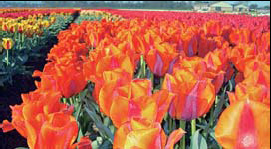Many Chinese know the Netherlands as the home of Philips, tulips, clogs and soccer superstars like Robin van Persie. At the World Expo 2010 in Shanghai, the bicycle-loving nation will demonstrate that it has far more to offer.


Happy Street, the name of the Netherlands pavilion designed by architect John Krmeling, resembles a 400-m-long street that winds around in the shape of the number "eight." Eight is considered an auspicious number in China because it sounds like the mandarin Chinese word for "prosperity".
Visitors to the pavilion can stroll along its 26 "houses" representing different Dutch architectural traditions, including works by late masters such as Gerrit Rietveld, a famous furniture designer, and Jan Wils, who designed the Olympic Stadium for the 1928 Summer Games in Amsterdam.
"We are confident that an open pavilion will always attract people," said Walter van Weelden, the Netherlands' Expo 2010 commissioner general.
"If you have to visit a closed block with an entrance and exit, it's a different story and you don't know what is inside."

As people can peer through windows to see the exhibitions inside, van Weelden said the pavilion would easily be able to accommodate an expected 7 million visitors during the expo period.
In addition to its distinctive structure and unique experience, the pavilion also offers forward-thinking presentations of such national symbols as tulips, windmills and clogs.
"These traditional logos will be shown in a more modern and innovative way," van Weelden said.

With a population of 16 million people and a total area of 41,000 sq km, the Netherlands is a model of efficiency and organization.
At the Shanghai gala, the Dutch will show how they are able to live below sea level, while also demonstrating their country's role as a global player in such fields as art, architecture and water management.
Apart from giving the world Van Gogh and Rem Koolhaas, the Dutch also produced the world's first stock exchange and multinational conglomerate.
The Netherlands has much to offer in terms of presenting livable cities in a largely urbanized and densely populated country.
Its pavilion aims to promote sustainability, environmental awareness and corporate social responsibility, showing, for example, its solutions to problems relating to space, energy and water.

